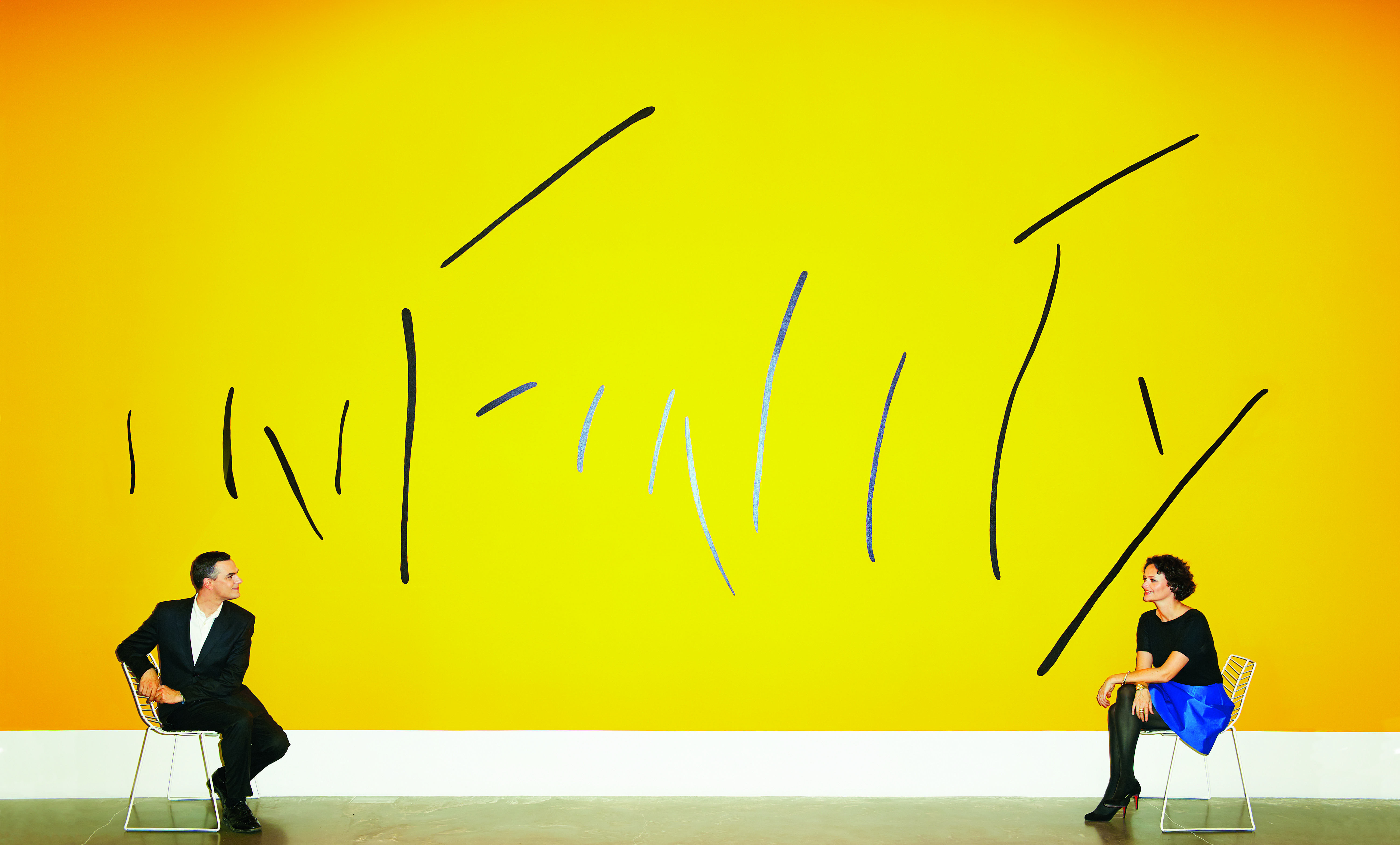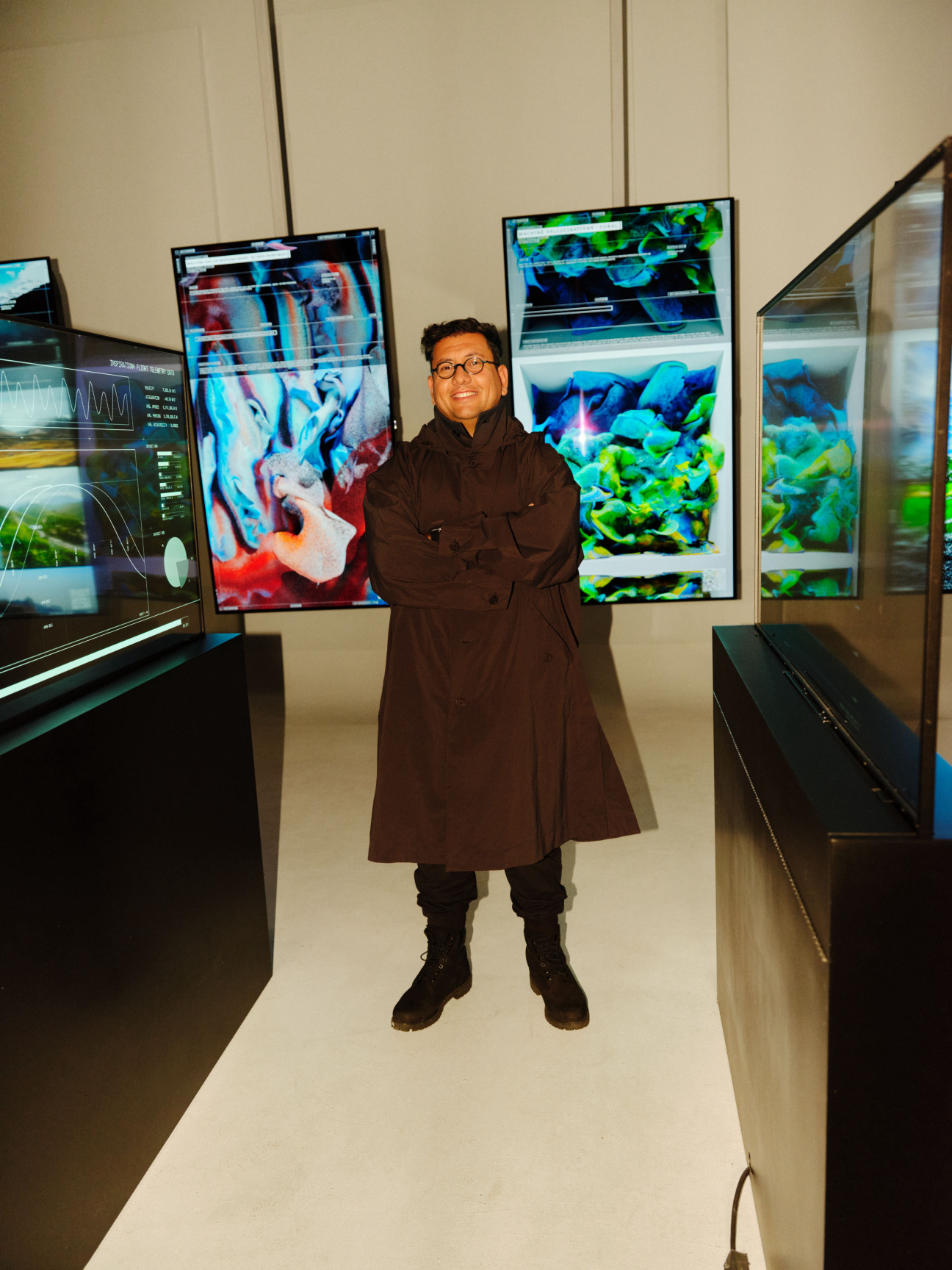
In the lobby of MoMA for the past few months, a huge LED screen has beamed an abstract CGI animation that morphs from blossoming clouds to splashing fountains of paint to lurid fungal blooms to pale, Surrealist pencil-like drawings. The audience sits and watches or mills around it. A little girl films the screen, holding up her phone and following its movements, swaying from side to side as though entranced. This is “Unsupervised,” 2022, an exhibition by Turkish artist Refik Anadol that makes a serious attempt to answer the question, What would a machine dream about after seeing the collection of the Museum of Modern Art?
Near the wall text that details the work’s concept, two young women explain artificial intelligence (A.I.) to a small kid in a Naruto hoodie: You don’t build an A.I., you train one.
“Like a computer?” he asks. “Kind of,” they respond, “but it learns.” Here, at the entrance of one of the greatest modern art museums in the world, it feels like we’ve reached the boundary of a new and strange territory. Time and space are being manipulated and represented in radically different ways, with 200 years of art history reimagined as a series of infinite-duration simulations on a 24-square-foot display.
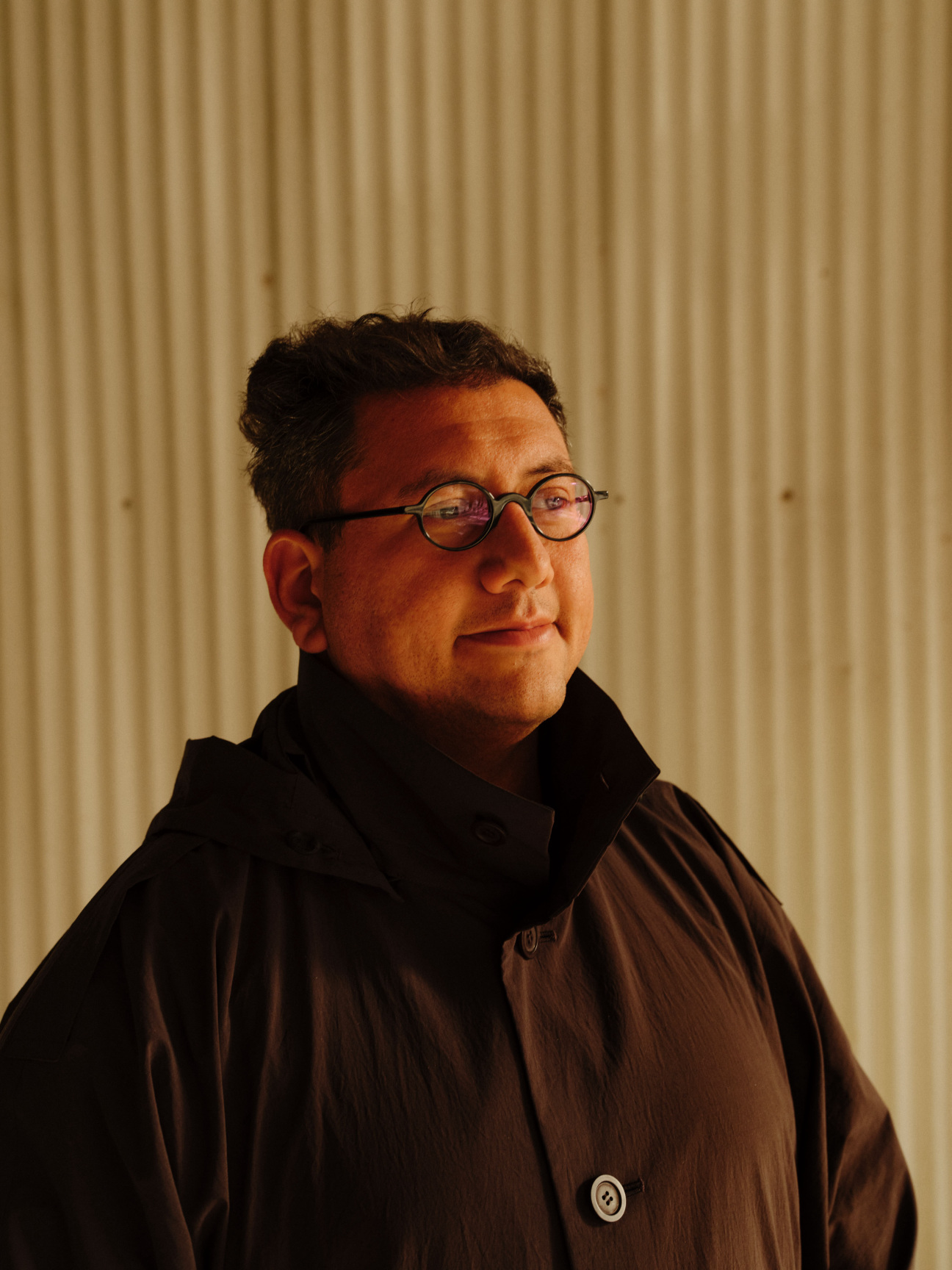
There has been a great deal of concern over the development of A.I. in the past year, particularly surrounding text-to-image A.I. diffusion models such as DALL-E and Midjourney. The ability to appreciate—and also make—art is one of the qualities that makes us unique among living beings. If software learns to create images—perhaps even art—what does that mean for artists? For humanity? The discourse around A.I. and art is very negative, when it’s written about at all. This incredible new technology is treated as an existential threat to our livelihoods, our intellectual property, and our spirit. Anadol, however, is focused on a different side of the story: he shows how artists can collaborate with A.I. harmoniously, and how similar advanced technologies might help art to move in unexpected directions, hopefully toward progress. He arrived at MoMA at the perfect moment.
Anadol was born in 1985 in Istanbul, the Turkish city that bridges Europe and Asia both geographically and culturally. “That was a really very powerful starting point in life,” he recalls, “when I think about the desire to connect the physical and virtual. It is a very similar feeling I think to connecting the West and East.” He grew up in a family of teachers in which, he says, “being a nerd is something that happens.” At eight years old he got his first computer, and throughout his youth he enjoyed playing and was fascinated by strategy games, and in particular StarCraft.
To make A.I. art in an ethical manner, Anadol believes it’s important that artists claim responsibility for the A.I. models they employ. Rather than off-the-shelf diffusion models, he uses bespoke GANs (Generative Adversarial Networks), a different sort of A.I. entirely. A GAN learns by putting two neural networks in competition with each other in whatever specific task they’re performing. Furthermore, rather than using a dataset of other people’s personal work—as is the case with some of the popular diffusion models—Anadol’s GANs are trained on vast datasets of what he calls “collective memories.” Things that he hopes “belong to humanity, like nature, space, culture, and cities. I try to look at the whole of nature as an input.” In 2020, for his exhibition “Quantum Memories” at the National Gallery of Victoria, Australia, he used 200 million photos of Earth—its landscapes, oceans, and atmosphere—as a dataset. In 2019, for “Machine Hallucination: NYC,” he used 113 million images of New York City, and for Sense of Space, at 2021’s Venice Biennale of Architecture, he used approximately 70 terabytes of MRI brain scans to build an immersive installation exploring the human mind.
Anadol is able to find great beauty in mathematics. It can often seem as if algorithms make today’s world smaller, but he finds ways of using them to make it feel larger, to create dazzling, immersive environments and spectacular outdoor projections. Over the years, he and his studio team of data scientists, researchers, designers, architects, and composers have trained more than 100 A.I. models on over 3 billion images. There is a famous Jorge Luis Borges story from 1946, On Rigor in Science, set in a world in which cartography develops into such a precise science that a map of the empire was the same size as the empire itself, and was laid on top of it, covering it. Eventually it fell into disrepair, although tattered fragments of the map could still be found, as Borges writes, sheltering the occasional beast or beggar. Anadol’s art practice, likewise, could be understood as a series of Borgesian software installations made from all the world’s memories and data, writing and coding a form of optimistic science fiction that takes our universe as its subject matter.
Now, for “Unsupervised,” he trained his GANs on 138,151 images of works from the MoMA collection. Having shown at institutions including the Centre Pompidou, Pinakothek der Moderne, and Walt Disney Concert Hall; participated in successful auctions with Sotheby’s and Christie’s; and joined the artist roster at Berlin’s König Galerie, Anadol has done more than almost anyone to transform data visualization into high art—for this project however, the data he visualized was art.
The project was born from an online exhibition on the NFT art platform Feral File in 2021. To begin, Anadol and his team downloaded the museum’s public collection of images and metadata from the hosting platform GitHub. Next, they used open-source software to build a complex map of the archive in a multi-dimensional digital space. They trained their GAN on the map and, months of learning later, had their supercomputer rendering a continuous dream-flow of surreal visions inspired by the history of modern art in real time; they’d stopped the training relatively early, in fact, because Anadol wanted the visuals to remain abstract, and not resemble other artworks or develop into recognizable forms. “People are mostly trying to mimic reality,” he says, “but in my mind, it’s much more inspiring to make A.I. have a fantasy than to recreate reality.”
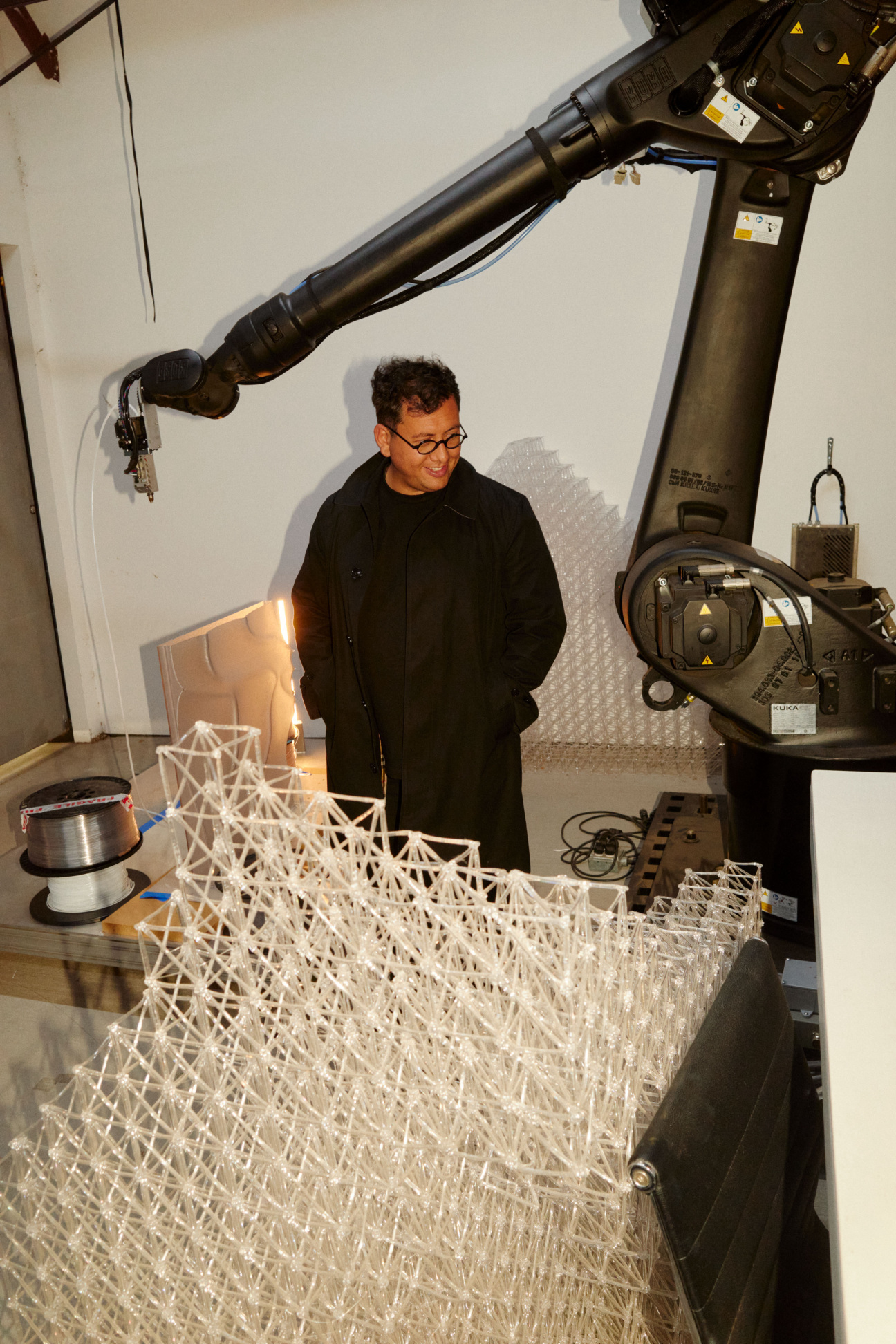
These are the supercomputer’s phosphene-like impressions of modern art. They are forms that might have existed in the archive, but don’t. By connecting many different visions across three centuries, the A.I. imagines paths not taken in art history, and paths that still might be taken in the future, giving them speculative forms and colors.
When he was invited to exhibit the project at MoMA the following year, Anadol decided to add yet more layers of data and remake “Unsupervised” as a site-specific installation. Eventually the surrounding environment (light levels, noise, the movement of the audience and staff through the lobby, the weather outside in the sculpture garden) crept into the machine’s dataset, affecting what it showed.
As such, “Unsupervised” is made up of three separate but intimately connected works—MoMA, Generative Study I, Fluid Dreams—drawn by GANs and rendered by bespoke software, appearing on the lobby screen one after another. The first, MoMA, sets the foundation upon which the following two works iterate. Hallucinatory traces of unrealized artworks, the A.I.’s visual interpretation of the MoMA archive, appear on the screen for a moment and fade away, never to be repeated. The second, Generative Study I, sketches new patterns on top of these A.I. hallucinations, connecting them with intricate gossamer webs. The third, Fluid Dreams, a signature form of Anadol’s, reimagines these interconnected visions as splashing effervescent surf, made up of around 100 million digital particles. Fluid Dreams is so complex, in fact, that it has to be rendered in advance— even Anadol’s specially crafted supercomputer cannot produce the visualization in real time. “This is my brush,” the artist says. “I’m not proud of my skills with drawing. I’m not proud of my skills using pen and paper, but I’m pretty confident that I can draw anything in my mind with a computer.”
No galleries found for this post.
Anadol has had a couple of great revelations in his career so far. The first came in 2009, during his studies at Istanbul’s Bilgi University, where he transformed the façade of Santralistanbul into a digital canvas. That’s when he came up with the idea of embedding media art into architecture using light as a material and data as a pigment. It’s also when he coined the term “data painting,” the idea that data can be given form, made visible, and be transmuted into bright, colorful pigments. “When I found that data is not just numbers—that data is a form of a memory—my mind was blown away,” he explains. “Since then I’ve felt like data can take any form, like a painting or a sculpture. It’s an infinite imagination because it’s not stuck in the reality of life. It doesn’t need to follow the rules of Newtonian physics; it goes beyond what we can do.”
It was in California, where he moved to get an MFA in the Department of Design Media Arts at the University of California, Los Angeles, that Anadol had the second of his great revelations. In 2016 he became an artist in residence at Google’s Artists and Machine Intelligence program.
Around that time, Google was developing its DeepDream A.I. (which runs on a convolutional neural network). He saw how A.I. algorithms might lead to new methods of image-making and completely new aesthetics. He realized that if a machine could learn, it could remember—and so it could dream, it could hallucinate. That’s when he coined the terms “A.I. data painting” and “A.I. data sculpture” to describe how data could be shaped and pigmented in collaboration with A.I. From there, he began his ongoing series of “Machine Hallucinations” works, of which “Unsupervised” is one, and set about training A.I.s to conjure visualizations based on different datasets. Now, his dream is to open a door to altered perception, revealing the world in a totally new way.
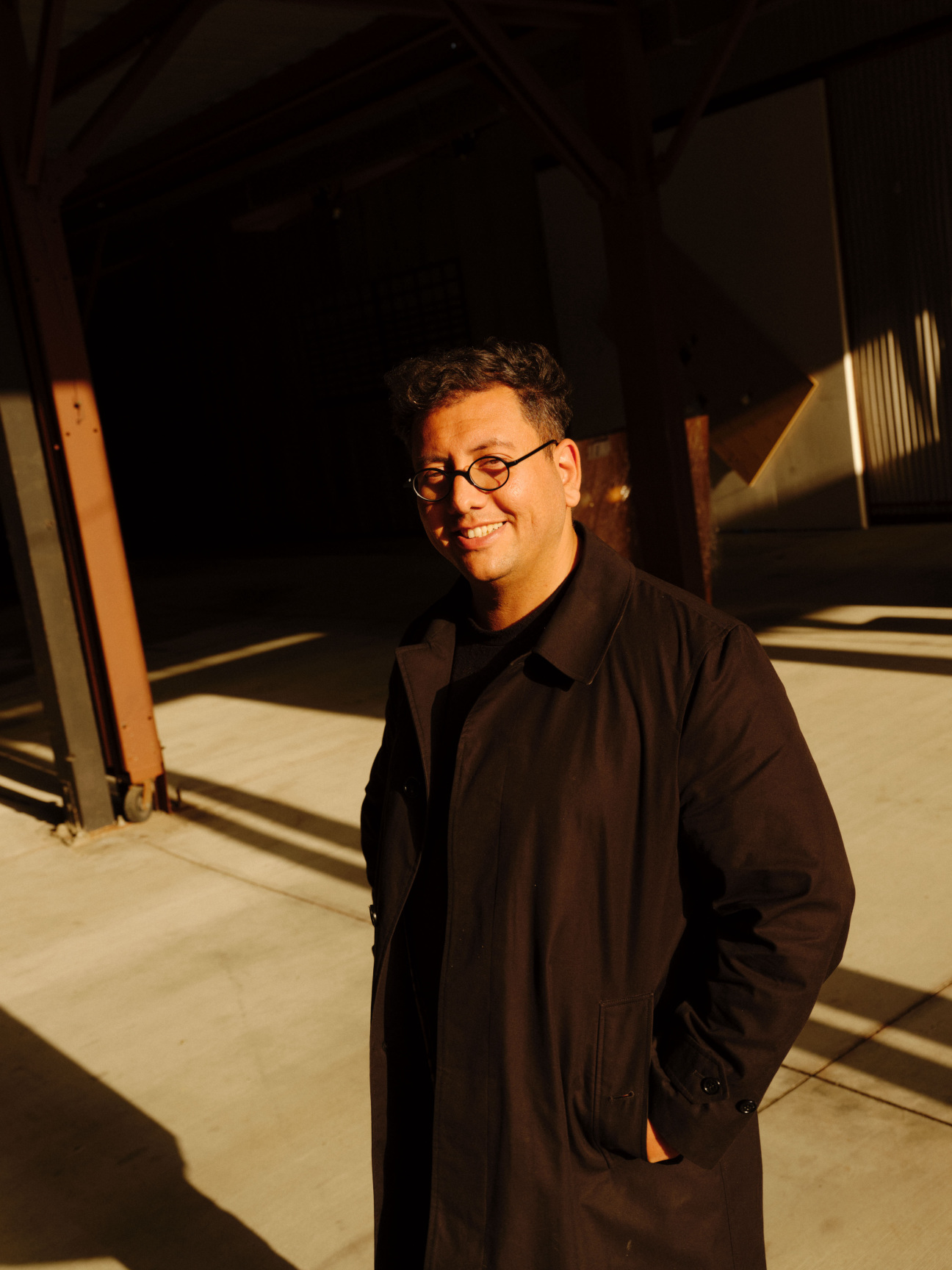
Asked whether he’s ever used psychedelics himself—real-world psychedelics, not psychedelic software—he replies, “I’m practicing. A couple of months ago I returned from Brazil—from the Yawanawá people in the Amazon—where I’ve been closely experimenting with plant medicines,” he says. “I don’t believe ‘Machine Hallucinations’ as a name can happen without understanding what ‘hallucination’ means… And psychedelics are a practice people see so much positivity around. I believe in ancient wisdom and I think they’re bringing that.” He has also been fantasizing, he says, about collecting the largest rainforest biome dataset in the world in collaboration with the Yawanawá and using it to grow an immersive, artificial-reality rainforest.
What sets Anadol apart from most artists today is his great optimism regarding technology—how it can change art, and how it can change us. “I don’t know any other plan than this. This is probably the only logical way to invent the language of humanity, by using the collective memories of humanity, collective dreams and collective consciousness.”
The “Machine Hallucinations” offer a new interpretation of the automatic writing practices used by artists of the 20th century Surrealist and Fluxus movements. While Anadol’s avant-garde predecessors relied on chance or accident, or found techniques for unconscious mark-making to achieve the effect of automatism, he uses algorithms whose outputs he can never quite predict. “I don’t believe the simple output of a machine can be art,” he says with excitement as we breeze past the end of our allotted interview time. “For me, the art is happening after the machine has given us an output.” While so many worry about A.I. replacing human artists, Anadol shows potential avenues for collaboration with it that only broaden the possibilities of self-expression and creative potential. “Interacting with an A.I. model is very much an artistic endeavor,” he concludes. “I’m the conductor at the end.”
"Unsupervised" is on view through March 5, 2023 at MoMA in New York. Refik Anadol's "Living Paintings" opens today and will be on view through April 29, 2023 at Jeffrey Deitch in Los Angeles.




